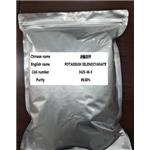Description
Potassium selenocyanate, a crystalline solid, is a reagent for the conversion of alkyl halides to nitriles and for the production of pharmaceutical intermediates. It is also used in the field of energy storage devices.
Chemical Properties
white to light beige crystalline powder or needles
Uses
Increasing interest in solid state NMR of heavy-metal nuclei results in the preparation of several Hg-thiocyanate and selenocyanate compounds as potential models. Bowmaker, G.A. et al.
Inorg. Chem. 1998, 37, 1734.
Uses
Potassium selenocyanate is used to prepare triphenylphosphine selenide by reacting with triphenylphosphine. It finds application in solid state NMR of heavy-metal nuclei which results in the preparation of several mercury thiocyanate and selenocyanate compounds.
Application
Potassium selenocyanate can be used to:
(1) Redox-active electrolyte to enhance the performance of carbon-based supercapacitors.
(2) Starting material for the one-pot stereoselective synthesis of alkyl styryl selenides.
(3) Precursor to synthesize Cu and Ni complexes with antioxidant/anti-inflammatory activities.
(4) Selenylating agent to prepare stereoselective selenoglycosides and selenium-linked disaccharides.
Safety Profile
Poison by
intraperitoneal route. When heated to
decomposition it emits very toxic fumes of
NOx, CN-, K2O, and Se. See also
SELENIUM COMPOUNDS and
CYANATES.
storage
Crystalline KSeCN is hygroscopic and decomposes with the elimination of selenium upon prolonged exposure to air. It should be stored in sealed containers. Potassium selenocyanate is a malodorous and highly toxic compound. All reactions and handling should be carried out in a well-ventilated hood.
Purification Methods
Dissolve it in acetone, filter and precipitate it by adding Et2O.








